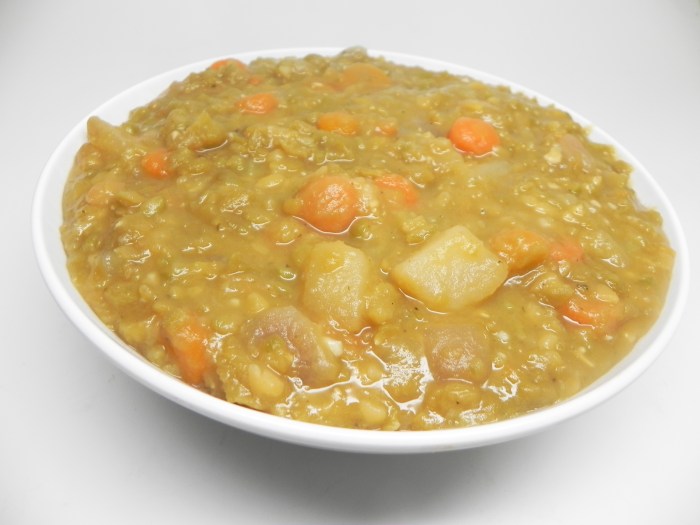
Split Pea Soup with Homemade Ham Bone Stock: A Flavorful Fusion
Split pea soup with homemade ham bone stock is a culinary masterpiece that brings together the comforting warmth of classic soup with the rich, savory depth of homemade broth. The combination creates a symphony of flavors that tantalizes the taste buds and nourishes the soul.
The homemade ham bone stock, simmered for hours with aromatic vegetables and herbs, infuses the soup with an unparalleled depth of flavor that elevates it from ordinary to extraordinary. The split peas, cooked until creamy and tender, absorb the rich broth, creating a luxuriously smooth and satisfying texture.
This dish is not just a meal; it’s a journey through culinary history, showcasing the power of simple ingredients to create a masterpiece. From the origins of split pea soup, a humble staple in various cultures, to the art of crafting homemade ham bone stock, each element contributes to the overall experience.
The result is a dish that is both comforting and sophisticated, perfect for a cozy evening or a special occasion.
The Allure of Homemade Ham Bone Stock

The aroma of simmering ham bone stock fills the kitchen with a comforting warmth, a promise of flavor that transcends mere soup. It’s a symphony of savory notes, a testament to the magic of slow cooking and the inherent richness of ham.
Homemade ham bone stock is a culinary treasure, a foundation for countless dishes that elevates their taste to new heights.
There’s something so comforting about a big pot of split pea soup, especially when it’s made with homemade ham bone stock. The rich flavor of the broth, infused with the essence of the ham, adds a depth that’s hard to replicate.
And if you’re looking for another way to make a flavorful stock, check out this recipe for whole chicken in a pan – the resulting broth is perfect for soups, stews, and even rice dishes. Back to the split pea soup, though – I like to add a dollop of sour cream and a sprinkle of fresh parsley to finish it off.
It’s the perfect meal for a cold winter day.
The Unique Flavor Profile of Homemade Ham Bone Stock
Homemade ham bone stock boasts a depth of flavor that commercially prepared stock simply cannot match. The slow simmering of the ham bone extracts its essence, creating a rich broth infused with umami, a savory taste sensation that tantalizes the palate.
This depth of flavor is further enhanced by the addition of aromatics like onions, carrots, and celery, which contribute their own unique notes to the final product.
Comparing Homemade and Commercially Prepared Stock
While commercially prepared stock offers convenience, it often lacks the nuanced complexity of homemade stock. The flavor of commercial stock is typically more muted, lacking the depth and richness that comes from slow simmering and the use of high-quality ingredients.
Additionally, commercial stock may contain additives and preservatives that can alter its natural flavor profile.
Creating a Flavorful Ham Bone Stock
The process of creating a flavorful ham bone stock is a simple yet rewarding one. It begins with the selection of a high-quality ham bone, preferably one with a good amount of meat attached. The bone is then rinsed and placed in a large stockpot, along with aromatics like onions, carrots, and celery, and a bouquet garni (a bundle of herbs tied together).
The pot is filled with cold water, and the mixture is brought to a simmer. The stock is then simmered for several hours, allowing the flavors to meld and develop.
There’s something so comforting about a big bowl of split pea soup with homemade ham bone stock, especially on a chilly day. It’s the kind of meal that warms you from the inside out. And if you’re looking for a sweet treat to go with it, I highly recommend trying these air fryer apple fritters.
They’re crispy on the outside, soft and gooey on the inside, and the perfect balance to the savory soup. After all, a balanced meal is key to a happy belly, right?
The key to creating a truly flavorful stock is to simmer it slowly over low heat for an extended period. This allows the flavors to extract from the bone and aromatics, creating a rich and complex broth.
After simmering, the stock is strained to remove the solids, leaving behind a clear and flavorful broth. The stock can be used immediately or stored in the refrigerator for up to five days or frozen for longer storage.
Split Pea Soup
Split pea soup is a classic comfort food enjoyed worldwide. It’s a hearty, flavorful soup that is perfect for a cold winter day or a simple weeknight meal. This versatile soup has a rich history and offers a variety of flavors depending on the region and ingredients used.
Origins and History
The origins of split pea soup can be traced back to ancient times. Peas have been cultivated for thousands of years, and split pea soup was likely a staple in many early civilizations. The soup’s popularity likely stemmed from its affordability and nutritional value.
Peas are a good source of protein, fiber, and vitamins, making them an essential ingredient in many cultures.
Split pea soup with homemade ham bone stock is a hearty and comforting meal that’s perfect for a chilly evening. The rich, savory broth infused with the smoky flavor of ham bone adds depth and complexity to the soup.
For a touch of heat, I like to add a dollop of easy blender red pepper sauce on top. The sauce adds a vibrant kick that complements the earthy flavors of the soup perfectly. It’s a simple addition that elevates the dish to another level of deliciousness.
Key Ingredients and Their Roles
The key ingredients in split pea soup are split peas, broth, and aromatics. The split peas provide the soup’s signature creamy texture and nutty flavor. The broth provides the base for the soup and adds depth of flavor. Aromatics, such as onions, carrots, and celery, add complexity and sweetness to the soup.
Other ingredients that are often added include ham, bacon, or sausage, which add richness and savory notes.
Variations of Split Pea Soup
Split pea soup has many variations around the world, reflecting different regional preferences and culinary traditions. Here are a few examples:
- German Pea Soup (Erbsensuppe):This hearty soup is often made with smoked pork or bacon, and sometimes includes potatoes, carrots, and onions.
- French Pea Soup (Soupe aux Pois Cassés):This classic French soup is typically made with ham, carrots, onions, and celery. It is often served with croutons or a dollop of crème fraîche.
- Indian Split Pea Soup (Dal):Dal is a staple in Indian cuisine and is made with split peas, lentils, and spices. There are many variations of dal, each with its unique blend of spices and ingredients.
The Perfect Pairing: Split Pea Soup With Homemade Ham Bone Stock

The marriage of ham bone stock and split pea soup is a culinary symphony, where each element elevates the other to create a truly harmonious dish. The rich, savory essence of the ham bone stock infuses the split peas with an unparalleled depth of flavor, transforming a simple soup into a culinary masterpiece.
Ham Bone Stock’s Enhancement
The key to this perfect pairing lies in the ham bone stock’s ability to enhance the split pea soup’s flavor profile. The stock, simmered for hours with the ham bone, releases a complex medley of savory notes: a gentle sweetness from the ham, a subtle tang from the bone, and a hint of umami from the rendered fat.
These flavors seamlessly integrate with the earthy sweetness of the split peas, creating a symphony of taste that is both comforting and sophisticated.
Texture and Consistency
The texture and consistency of split pea soup are significantly impacted by the choice of broth. Ham bone stock, with its naturally gelatinous quality, creates a luxuriously smooth and creamy split pea soup. The gelatin, released from the bones during simmering, acts as a natural thickener, adding a velvety texture that coats the palate.
In contrast, broths made from vegetables or chicken tend to yield a thinner soup, lacking the richness and body achieved with ham bone stock.
Recipe for Split Pea Soup with Ham Bone Stock
Ingredients
- 1 ham bone (from a roasted ham)
- 1 onion, chopped
- 2 carrots, chopped
- 2 celery stalks, chopped
- 1 cup dried split peas, rinsed
- 8 cups homemade ham bone stock
- 1 teaspoon salt
- 1/2 teaspoon black pepper
- 1 bay leaf
- Fresh parsley, for garnish
Instructions
- In a large pot or Dutch oven, combine the ham bone, onion, carrots, celery, split peas, ham bone stock, salt, pepper, and bay leaf.
- Bring to a boil, then reduce heat to low, cover, and simmer for 1-1.5 hours, or until the peas are tender and the soup has thickened.
- Remove the ham bone and discard.
- Using an immersion blender, puree a portion of the soup to achieve your desired consistency. Alternatively, you can transfer the soup to a regular blender in batches and puree.
- Serve hot, garnished with fresh parsley.
This recipe is a testament to the power of simplicity. The key lies in the quality of the ingredients, especially the homemade ham bone stock, which adds a depth of flavor that is simply unmatched.
Split Pea Soup Variations and Presentation
Split pea soup, a humble yet hearty dish, offers endless possibilities for customization. Beyond the classic recipe, there are countless ways to explore different flavors and textures, making it a versatile culinary canvas. From adding smoky bacon to incorporating vibrant spices, each variation offers a unique flavor profile, catering to diverse palates.
Furthermore, presentation plays a crucial role in elevating this simple soup into a visually appealing and satisfying meal.
Split Pea Soup Variations
Exploring various ingredients and flavor combinations can significantly enhance the taste and appeal of split pea soup. Here’s a table showcasing different variations, each offering a unique flavor profile and serving suggestion:
| Variation | Ingredients | Flavor Profile | Serving Suggestions |
|---|---|---|---|
| Classic Split Pea Soup | Split peas, ham bone stock, carrots, celery, onion, bay leaf, salt, pepper | Earthy, savory, with a hint of sweetness from the vegetables | Served hot with crusty bread or a side of cornbread |
| Smoky Bacon Split Pea Soup | Split peas, ham bone stock, carrots, celery, onion, bay leaf, bacon, smoked paprika, salt, pepper | Rich, smoky, with a hint of spice | Served hot with a dollop of sour cream or a sprinkle of chopped chives |
| Curried Split Pea Soup | Split peas, ham bone stock, carrots, celery, onion, bay leaf, curry powder, coconut milk, salt, pepper | Warm, aromatic, with a hint of coconut sweetness | Served hot with a side of basmati rice or naan bread |
| Spicy Chorizo Split Pea Soup | Split peas, ham bone stock, carrots, celery, onion, bay leaf, chorizo sausage, chili powder, cumin, salt, pepper | Spicy, savory, with a hint of heat | Served hot with a dollop of Greek yogurt or a sprinkle of cilantro |
Presentation and Garnishes, Split pea soup with homemade ham bone stock
The presentation of split pea soup plays a significant role in elevating its visual appeal and enhancing the overall dining experience. Garnishes, strategically added, can transform a simple bowl of soup into a visually captivating dish.
“Garnishes add a touch of color, texture, and flavor, enhancing the visual appeal and taste of the dish.”
A beautifully plated split pea soup could feature:
- A swirl of cream or a dollop of yogurt for richness and a creamy texture.
- A sprinkle of chopped fresh herbs like parsley, chives, or cilantro for a burst of freshness and color.
- Toasted croutons or a drizzle of olive oil for a crispy texture and added flavor.
- A sprinkle of smoked paprika or chili flakes for a hint of spice and color.
- A garnish of roasted vegetables like diced carrots, celery, or onions for a contrasting texture and flavor.
The choice of garnishes should complement the overall flavor profile of the soup and enhance its visual appeal. For instance, a sprinkle of fresh herbs would complement a classic split pea soup, while a dollop of Greek yogurt would be a perfect addition to a spicy chorizo variation.
Split Pea Soup and its Nutritional Value
Split pea soup is not just a comforting and flavorful dish; it’s also a nutritional powerhouse packed with essential vitamins, minerals, and fiber. The humble split pea, along with the homemade ham bone stock, contribute to a well-rounded meal that nourishes your body and mind.
Nutritional Benefits of Split Peas
Split peas are an excellent source of protein, fiber, and various vitamins and minerals.
- Protein:Split peas provide a significant amount of protein, making them a great option for vegetarians and vegans. A single cup of cooked split peas contains approximately 18 grams of protein, contributing to muscle growth and repair.
- Fiber:Split peas are rich in both soluble and insoluble fiber. Soluble fiber helps lower cholesterol levels and regulate blood sugar, while insoluble fiber promotes digestive health and regularity. The high fiber content in split peas can help you feel full and satisfied, making it a good choice for weight management.
- Vitamins and Minerals:Split peas are a good source of several essential vitamins and minerals, including folate, iron, potassium, and magnesium. Folate is crucial for cell growth and development, while iron supports red blood cell production. Potassium helps regulate blood pressure, and magnesium plays a role in muscle function and energy production.
Health Benefits of Homemade Ham Bone Stock
Homemade ham bone stock, the base for our split pea soup, adds another layer of nutritional value. While ham bone stock may not be suitable for everyone, it offers potential health benefits when consumed in moderation.
- Collagen and Gelatin:Ham bone stock is rich in collagen and gelatin, which are proteins that contribute to joint health, skin elasticity, and gut health. These proteins can help reduce inflammation and improve joint mobility. Additionally, gelatin can help support a healthy gut lining.
- Minerals:Ham bone stock is a good source of minerals such as calcium, magnesium, and phosphorus. Calcium is essential for strong bones and teeth, magnesium supports muscle function and energy production, and phosphorus plays a role in bone health and energy metabolism.
- Antioxidant Properties:Ham bone stock may contain antioxidants that can help protect your cells from damage caused by free radicals. Antioxidants are thought to contribute to overall health and disease prevention.
Tips for Making Split Pea Soup a Healthy and Satisfying Meal
- Use Low-Sodium Stock:When using store-bought stock, choose a low-sodium variety to control your sodium intake. You can also make your own stock using vegetables and herbs for a healthier option.
- Add Vegetables:Incorporate a variety of vegetables into your split pea soup, such as carrots, celery, onions, and potatoes. These vegetables add flavor, texture, and additional nutrients to your soup.
- Choose Whole Grains:Instead of white rice, consider adding whole grains like barley, quinoa, or brown rice to your soup. Whole grains provide fiber, vitamins, and minerals, making your soup even more nutritious.
- Control Portions:While split pea soup is a healthy and satisfying meal, it’s important to control portions. A single serving should be about 1 cup to avoid overconsumption of calories and sodium.






